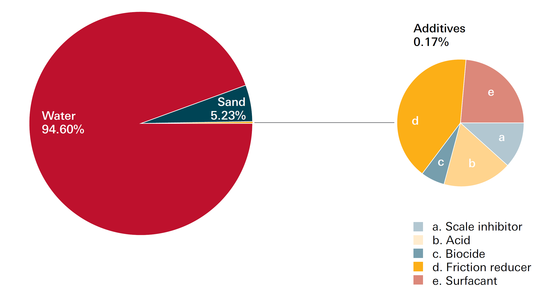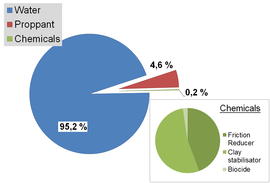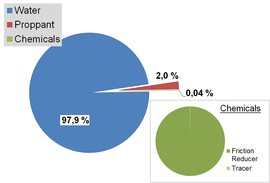Fracturing Fluids: Types, Usage, Disclosure
Fluids used for hydraulic fracturing purposes are called fracking fluids or fracturing fluids. They are injected into drilled boreholes under high pressure, in order to create targeted fractures and fissures in gas-bearing bedrock. After the fracturing operation, the fracturing fluid in the wellbore has to be removed, so that natural gas can be produced from the well.
The fluid is removed simply by decreasing the pressure in the wellbore after the hydraulic fractures have been produced. During this flowback-phase, part of the fluid flows back to the surface where it is collected, treated, disposed of or re-used. Only a fraction of the fracturing fluid flows back to the surface; a considerable amount of the originally introduced volume remains underground.
Fracturing Fluid = Base Fluid + Additives + Proppant
So-called “slickwater” fracturing fluids are commonly used in shale gas hydraulic fracturing operations. They are water-based and include proppants and chemical additives. The term´slickwater´ infers that the water has lower viscosity than regular water, to reduce friction loss in the pipe while injecting the fluid. This is accomplished by adding friction-reducer to the fluid.
Slickwater fracturing fluids usually contain 98-99 vol% of water, and include 1-1.9 vol% of proppants and typically less than 1 vol% of additives (King, 2012). Proppants, small grains of sand or ceramics, settle in the created fractures. When the pressure is released at the end of the fracturing operation, proppants keep the tiny fractures open, and thus ensure increased gas flow from the shale to the wellbore. Various chemical additives support the success of the fracturing operation. For fracturing operations in a single well, 10,000 to 25,000 m3 of water are required (Broomfield, 2012).
Chemical additives: Types and volumes
The numbers and volume of additives used may differ from one shale play to another, depending on the properties and the depth of the target shale, among other things. Therefore, a large variety of fracturing fluid additives exists (Tab.1).
Tab. 1: An overview of common additive classes, their purpose and some examples.
| Additive Class | Purpose | Examples |
|---|---|---|
| Biocide | Avoiding growth of bacteria and other fauna | Terpenes, isothiazolinones (e.g. 1,2-benzisothiazol-3-(2H)-one or 2-methyl-4-isothiazolin-3-one) |
| Buffer | pH control | Anorganic acids and bases (e.g. hydrofluoric acid, ammonium bisulfite) |
| Breaker | Reducing viscosity, enhanced fluid retrieval | Sulfates, peroxides (e.g. Ammonium persulfate, calcium peroxide) |
| Corrosion Inhibitor | Protect casing and equipment | Acids, alcohols, sulfites, (e.g. 2-butoxyethanol, amine bisulfite) |
| Crosslinker | Support gel formation, increase viscosity for proper downhole transportation of sand. | Borates, transition metals in combination with complexing agents (e.g. zirconiumoxide, -sulfate) |
| Friction Reducer | Creates laminar instead of turbulent flow | Polyacrylamide, petroleum distillates, e.g. aromatic hydrocarbons (benzene, toluene) |
| Gelling Agent | Support gel formation, increase viscosity for proper downhole transportation of sand, ideal proppant carriage | Guar gum, hydroxyethylcellulose, polymers (e.g. acrylamidcopolymers, vinylsulfonates) |
| Scale Inhibitor | Avoid precipitates from mineralic scalings that may build up at the inner wall of the casing or in the wellhead | Acids, phosphonates, (e.g. dodecylbenzene, sulfonic acid, calcium phosphonate) |
| Surfactant | Emulsification and salinity tolerance | Amines, glycol ethers, nonylphenol ethoxylates |
However, only a small number are used when it comes to the fracturing of a specific shale gas well. A general example of potential additives and their amounts is displayed in Fig. 1. Concrete fluid compositions may differ significantly, however, see Fig. 2.
 Fig. 1: Generalized example of fracturing fluid composition for shale fracturing. Additives such as friction reducers and biocide are frequently used, the other additives shown are used in far fewer operations, depending on the shale properties (King, 2012). Source: Shale gas extraction in the UK: a review of hydraulic fracturing (2012).
Fig. 1: Generalized example of fracturing fluid composition for shale fracturing. Additives such as friction reducers and biocide are frequently used, the other additives shown are used in far fewer operations, depending on the shale properties (King, 2012). Source: Shale gas extraction in the UK: a review of hydraulic fracturing (2012).Usage of additives
The additives are typically used in a sequential way during the entire fracturing process (U.S. EPA, 2011). Not all steps are performed in every fracturing operation. Possible steps are:
- An acidic treatment - often coupled with the use of a corrosion inhibitor - cleans up the perforated borehole casing.
- During the actual fluid grouting, friction reducers are applied for optimum pump rates. Proppants are added, sometimes together with gelling agents and/or cross-linkers.
- After the fractures and fissures have been created, breakers may be added to the fluid to reduce its viscosity and enhance its recovery.
- Other chemicals are sometimes blended in, to meet the specific requirements of the gas extraction method. Biocides, as well as scale inhibitors, serve to avoid a deterioration in the performance of the gas well, caused by bacterial or mineral matter. The use of buffers may ensure the reliable interaction of introduced chemical agents under the prevailing geochemical conditions, and surfactants can reduce the surface tension of fluids.
Disclosure of fracturing fluid composition
Shale gas operators are continually called upon to fully disclose the composition of the fracturing fluids and to fully report the volume and the types of additives used. This has become an important issue in the public debate because some of the additives that have been and/or are still being used are hazardous or toxic in their pure form. The industry has reacted slowly to this request, although at the present time some companies do disclose these data.
Part of the reason for that disclosure is the fact that it has been made mandatory in some US states by law. For the U.S. and Canada, fracturing fluid compositions and other data can be accessed on a well-to-well basis on the website FracFocus (U.S. / Canada). In the US, about 35,000 wells were registered by January 2013. It should be noted that FracFocus has been criticized for being incomplete and for allowing operators to claim trade secrets and thus circumvent full disclosure.
In Europe, as of today, the compositional data of fracturing fluids are only available for one shale gas fracturing operation in the UK (Cuadrilla), from Poland (BNK) and for a number of fracturing operations in Germany (ExxonMobil: mainly in tight gas reservoirs, only one in shale: “Damme 3”).
The Wirtschaftsverband Erdöl- und Erdgasgewinnung (WEG, German Industrial Association of Oil and Gas Producers) also provides information on fracturing fluids used in tight gas reservoirs in Germany (Exxon Mobile, RWE Dea, GDF Suez) on its platform. Since summer 2013 the International Association of Oil and Gas Producers (OGP) runs the web-based European platform NGS Facts (Natural Gas from Shale - hydraulic fracturing Fluid and Additive Component Transparency Service) on which it publishes the chemical fracturing additives used in shale gas wells.







